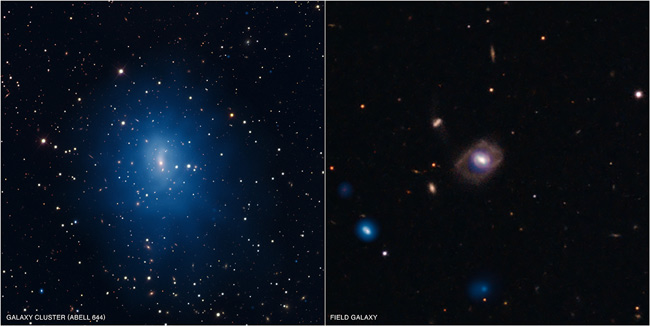Images Reveal Clues to Universe's Friskiest Black Holes

Some of the giant black holes that lurk at the center of galaxies are more lively than others, and the most hyperactive of these black holes put on showy displays, burning bright with X-rays as heated gases are sucked into their darkened hearts.
Astronomers aren't sure why these black holes are more active than their relatively subdued brethren, but a new large-scale survey of galaxies may help narrow down the possible answers. [New images of galaxies with active black holes]
Using the combined forces of NASA's Chandra X-ray Observatory and optical images from the Sloan Digital Sky Survey, scientists analyzed 100,000 galaxies in a huge swath of sky.
Only about 1,600, or one percent, of the galaxies surveyed were bright in X-rays — a telltale sign of heightened activity at a galaxy's center that suggests a black hole in its most hectic phase.
"Trying to figure out how many of these black holes are active at any time is important for understanding how black holes grow within galaxies, and how this growth is affected by the environment," said Daryl Haggard of the University of Washington in Seattle and Northwestern University in Evanston, Ill., who led the study.
Haggard and his team looked only at loner galaxies — as opposed to galaxies grouped together in clusters — focusing the research primarily on those galaxies within 1.6 billion light-years of Earth, although galaxies as far away as 6.3 billion light-years were studied.
They discovered that a galaxy's mass is correlated with the activity of its black hole; the more massive galaxies are far more likely to house a feisty center.
Get the Space.com Newsletter
Breaking space news, the latest updates on rocket launches, skywatching events and more!
In addition, researchers found that since the Big Bang, the percentage of galaxies that host hyperactive black holes has gone down — which implies that either the fuel supply or the fueling mechanism for the black holes is changing with time.
The study also has important implications for understanding how the company a galaxy keeps affects the growth of its black hole. It turns out that loner galaxies and galaxies in clusters are equally likely to house an active black hole.
"It seems that really active black holes are rare but not antisocial," Haggard said. "This has been a surprise to some, but might provide important clues about how the environment affects black hole growth."
Most galaxies are thought to house giant black holes in their centers, including our own Milky Way. While our galaxy's supermassive black hole is not overly active now, it could ramp up in the future, scientists say.
If that happens, life on Earth isn't in any danger. In fact, from our safe vantage point on the outskirts of the Milky Way, we'd get a spectacular show in the X-ray and radio wavelengths, according to astronomers.
However, for any planets closer to the galaxy's center, the news isn't so good — they could receive large and potentially damaging amounts of radiation.
Join our Space Forums to keep talking space on the latest missions, night sky and more! And if you have a news tip, correction or comment, let us know at: community@space.com.

Space.com is the premier source of space exploration, innovation and astronomy news, chronicling (and celebrating) humanity's ongoing expansion across the final frontier. Originally founded in 1999, Space.com is, and always has been, the passion of writers and editors who are space fans and also trained journalists. Our current news team consists of Editor-in-Chief Tariq Malik; Editor Hanneke Weitering, Senior Space Writer Mike Wall; Senior Writer Meghan Bartels; Senior Writer Chelsea Gohd, Senior Writer Tereza Pultarova and Staff Writer Alexander Cox, focusing on e-commerce. Senior Producer Steve Spaleta oversees our space videos, with Diana Whitcroft as our Social Media Editor.